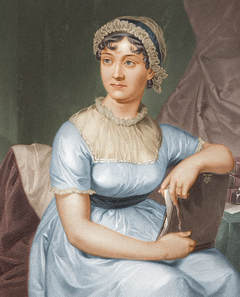 Many of my friends - and at least some of my readers - will know of my fondness for Jane Austen. Last week marked the 200th anniversary since her untimely death. She only reached the relatively young age of 42 when she passed away, from what is now theorised to be Addison’s Disease. This is a condition where the adrenal gland fails to produce sufficient hormones for the body to function. These days medication sorts out most Addison’s sufferers, but in Jane’s day no such treatment existed. In a small post on my Facebook page (feel free to “Like” my page here) I marked the day by wondering what treasures we might have had, if she’d lived a little longer. But, with six main published works to her name (Sense and Sensibility, Pride and Prejudice, Emma and Mansfield Park all published in her lifetime; Northanger Abbey and Persuasion published posthumously) she certainly made her mark. In fact, I’d go so far as to say that I think dear Jane would be shocked beyond belief at the ongoing interest in - and love for - her works. These days, Jane Austen spin-offs are a dime a dozen. A number of authors have attempted sequels to Pride and Prejudice, extrapolating the lives of Elizabeth and Darcy into the future. The story has been told from Darcy’s point of view, from the view of the servants in the house, from the perspective of their offspring and even, in one case, how they became involved in a murder mystery. Some of her novels have been updated for modern times, the core elements of her stories woven into current settings. There are even ‘time slip’ novels with characters from Jane’s novels coming to our time, and vice versa. She’s been used as the basis for a ‘theme park’, a drawcard for a book club and an alleged excerpt from Jane’s own life made it onto the silver screen in 2007. I have, of course, pondered why Jane’s works have garnered such enduring interest and devotion. An article I read recently (in UK’s Writing Magazine, July 2017, by Sophie Beal) suggested that Jane would probably have trouble even getting published today. The reasons for this were ten-fold: slows starts, too much backstory, no diversity, old-fashioned values, telling instead of showing, insipid/passive heroines, having the main action ‘off-stage’, superfluous characters, lack of realism. That’s quite a list. However, as Sophie points out, a work is the sum of its parts and therein lies Jane Austen’s skills. A partial answer to her ongoing popularity can be found in the magic of her prose, the way she so ably captured the social mores of the time with wit and irony. Readers of today come to know and understand the complexities that those times brought for women, and to see what a minefield all those manners and etiquette created. Themes such as hopes for the future and wanting to be valued also resonate because such issues are timeless and part of the human condition. After all, who doesn’t want to hear words such as those uttered by Mark Darcy in another Pride and Prejudice spin-off, Bridget Jones’s Diary, when he says, ‘I like you very much, just as you are.’ Her heroes and heroines, too, are not perfect. Some, like Elizabeth Bennet, are as equally able to laugh at their own follies as they are to laugh at the follies of others. They make mistakes, are too quick to judge or end up the victims of the mistakes and judgements of others. But, when all is said and done, they overcome rejection and adversity in order to get to their happily ever after. So here’s to Jane Austen. I know her works have made my life richer for the reading. May she continue to inspire, entertain and educate for many more centuries to come.  My visit to Jane Austen's house, Chawton, England, in 2013.
0 Comments
|
Author's BlogComing soon. . . Archives
June 2019
Categories |
 RSS Feed
RSS Feed